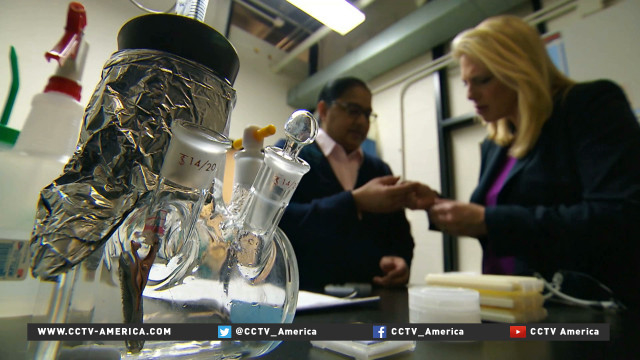Even with the robust sales, solar panels aren’t terribly efficient, converting only about 10-15 percent of the sun’s rays into useable and storable energy. A group of scientists are hoping to improve that and they are inspired by nature. CCTV America’s Jessica Stone reported this story from Albany, New York.

Sun and water are what create energy for all green plants through photosynthesis. Plants use sunlight to split water molecules and release electricity.
K.V. Lakshmi, an associate professor at Rensselaer Polytechnic Institute’s Center for Solar Energy is leading a team of 14 scientists working to unlock the secret how plants do this.
“This is the holy grail, and this catalyst actually evolved in nature. It’s a natural catalyst. It’s evolved in nature and this is what it does. It binds two molecules of water, uses four photons of light, and it splits the water into electrons and protons,” Lakshmi said of what her team hopes to accomplish by copying nature.
The goal is to develop the solar panel of the future, one that uses sun and water to create electricity and gets as high as 40 percent efficiency.
Right now, solar panels are made of silicon which has a limited supply, but Lakshmi’s lab is making solar panels out of chemicals found in the environment. Their panels are completely sustainable.
It all starts in the grow room where researchers attempt to isolate proteins from cells, purify them, and study the mechanisms — especially the protein that is a catalyst for splitting water. The protein works in four steps, and in seven years, Lakshmi’s team has discovered two of those steps. They are currently working on the third. The fourth and final step is what releases the energy.
“That’s what we need to figure out,” Lakshmi said, adding that it could take about five years to unlock the secret.
But the team isn’t waiting to understand the final step before designing a prototype for a solar panel. It’s already experimenting with man-made molecules which duplicate photosynthesis.
Efficiency is upwards of 25-30 percent right now, triple what’s currently available on the market, Lakshmi said.
Solar energy historian John Perlin discusses sun’s power
CCTV America interviewed John Perlin, a solar energy historian and author of the book “Let It Shine: The 6000-Year Story of Solar Energy” about the growth and limitations of solar power.

 CGTN America
CGTN America
